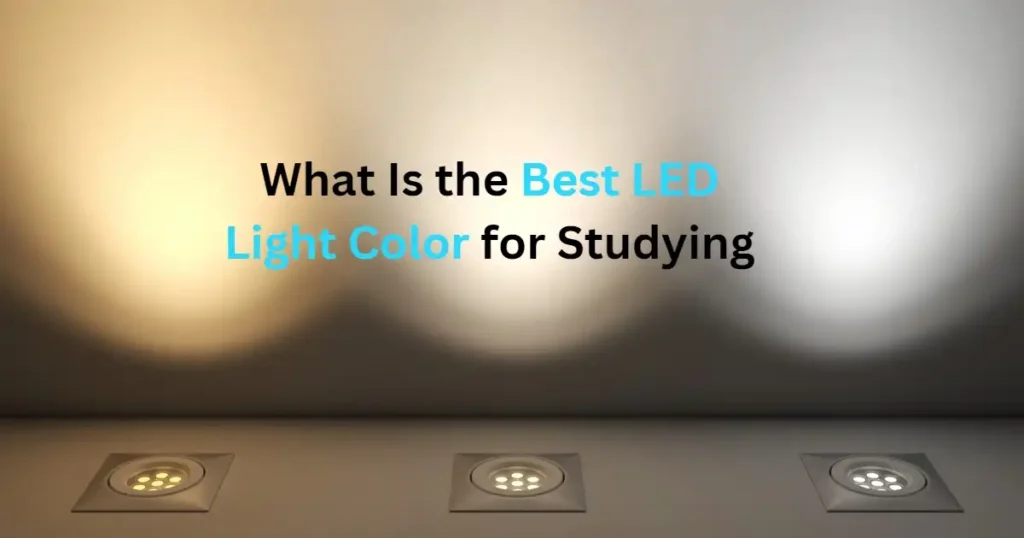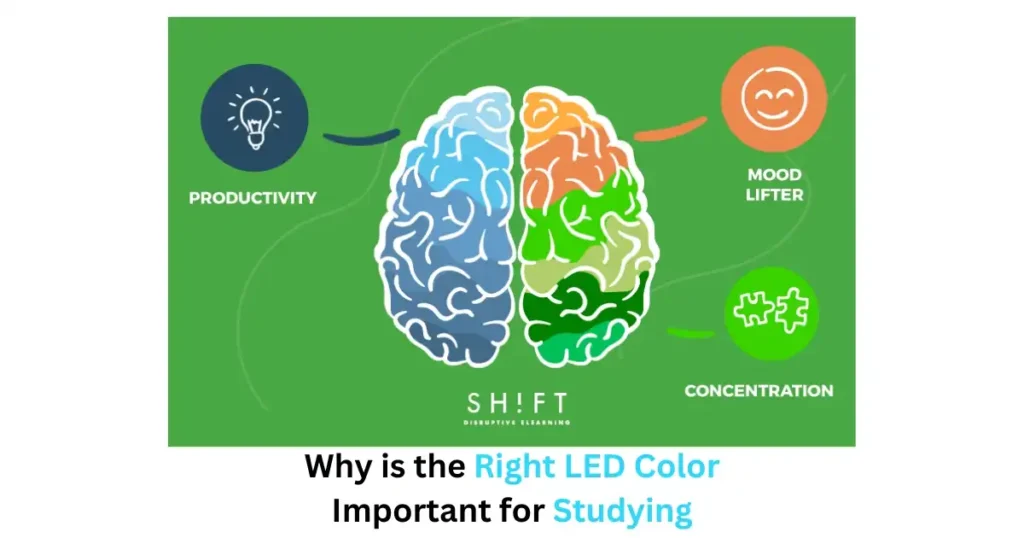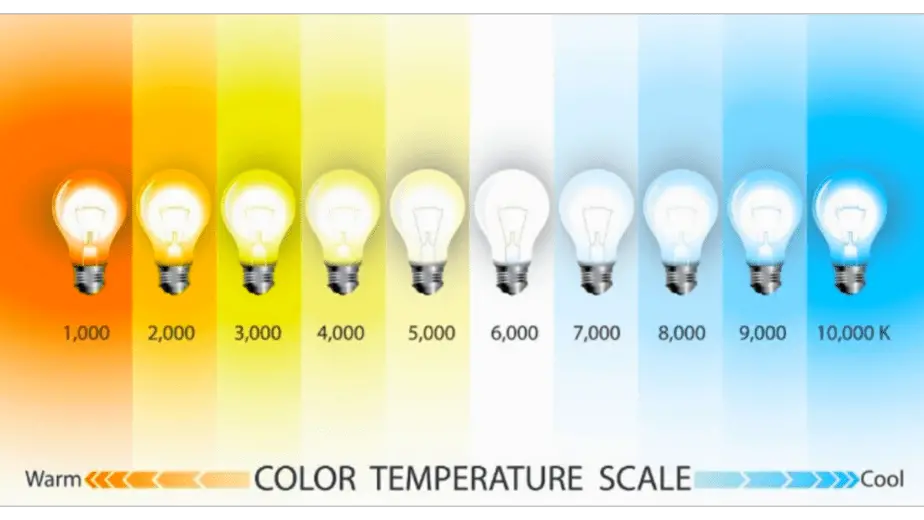If you’re an avid user of LED lights, it is normal for you to use your lights for decorative and aesthetic purposes. But did you know that you can also use your LED lights for studying and other productive activities?
This may come as a complete shock to someone who isn’t familiar with LED lights, but research has shown that LED light colors with certain color temperatures can assist the human brain with focusing and attention.

So if LED lights do help increase productivity, what is the best light colors for studying? Let’s dive deep and find out.
Why is the Right LED Color Important for Studying?
There are a few reasons why it is very important that you know what is the best light source for studying. The reasons are:
1. The right light color light can help you better distinguish the things you’re studying. For example, warm light that is similar to the color of the letters or graphics in your book will make it difficult for you to concentrate on them.
2. Certain colors help your brain generate certain hormones within your brain that can increase your focus and productivity. It is important that you keep those colors in the surroundings of your study area.
3. The wrong light color may cause you to become drowsy and relaxed, which is definitely not how you want to be when studying.

4. In addition to focusing, it is also important to be able to study for long periods of time without tiring yourself. Lights that are too bright may fatigue your eyes very quickly.
5. In addition to the color, the way the light is spread out over your studying area is also very important. A light that is too focused may cause eye strain, whereas a light that is too ambient can divert your concentration away.
Let’s Dive Into Color Temperature
Before going into the details, let’s talk about the Kelvin Color Temperature scale. The scale is used to explain how different light temperatures appear visually.
Ranging from 1,000K to 10,000K, the lower end of the scale includes hues of the warmest colors. These colors come to include red, orange, and yellow.

As you progress up the scale, the undertones become cooler and bluer. The higher end of the spectrum will have bright white colors with blueish undertones.
In order to truly find out what is the best light color for studying is, you need to know exactly how these colors affect our brain.
2700K – 3000K
A 2700K color temperature means that at 2700 Kelvin temperature, a traditional incandescent bulb would have that exact color. Although 2700K and 3000K light temperatures are very similar, there is a subtle difference visually.
Extensive research shows that light waves of warmer temperatures enable the brain to release a blend of hormones that help the human body relax. Therefore these temperatures should only be used for areas where you need a calm and cozy environment.
So, although 2700K and 3000K are ideal LED light colors for sleep, we would NOT recommend warm light for studying. These color temperatures will not help you with your productivity.
3000K – 4000K
Compared to the likes of 2700K these above color temperatures are cooler, meaning that at this range the lights start losing their warm orange undertones and have a more subtle yellow hue and looks like natural light.
Even though 3000K whites are cooler compared to 2700K, they should still not be an option when considering what is the best light color for studying. Temperatures like 3000K are suitable for living room lighting where you want to relax and wind down after a busy day.
Although 4000K lights still have warmer hues, some people prefer this temperature for productivity as they want some warmth in the illuminated areas.
4000K – 5000K
Once you have crossed the 4000K mark, the lights start losing the slight undertones and almost have a pure cool light white color. This is why the 5000K color temperature is known as neutral white.
Just like warm temperatures help you relax and calm down, cooler color temperatures like 5000K and above help you stay focused and productive. This is why you see neutral white and daylight colors in office and factory spaces.
For domestic use, cool white lights are appropriate for areas where you need to stay alert and concentrated. Areas like the workspace and kitchen are perfect for using 5000K LED lights.
How to Setup Perfect Lighting for Your Study
Now that you know how the color temperature scale works and exactly how your brain reacts to color temperatures, it should come as no surprise that the answer to what is the best type of light for studying is 5000K or slightly above temperatures.
Neutral white or daylight color temperatures makes your brain understand that you need to be in a productive and attentive mindset while under these lights, thus causing it to release hormones that increase your concentration levels.
While choosing the right color temperature is good and all, it is not the only aspect of lighting that you need to worry about while studying. You also need to be careful about the lighting position, intensity, ambiance, etc.
Although large fluorescent room lights are adequate, we recommend going for a table lamp with a cool white bulb while the surroundings of the study area are dark.

Having a table lamp allows you to control how far away the lamp is, thus you can modify the intensity of the light to your liking. Bring the lights closer if you’re reading small letters, and place them further away if you’re looking at a large area like a screen.
Moving the lamp also allows you to control the ambiance of the light. For higher ambiance, place the lamp further away and vice versa. If you have RGB lighting strips installed, use them at low brightness to provide ambient lighting.
Finally, having darker surrounding areas help you drown out the distractions that are present around your study area.
If you truly want the most versatile lighting option while studying, we recommend using a table lamp with a smart LED bulb. This way, you’ll be able to control the intensity, brightness, and even the color temperature using your smartphone.
Extensive research shows that light temperatures between 2700K and 3000K light is best for reading and studying at night. These light temperatures are also known as warm white or soft white, and they produce a cozy and relaxing atmosphere. Warm white light is gentle on the eyes and does not interfere with the production of melatonin, a hormone that regulates the sleep cycle. Therefore, using warm white light for reading at night can help you fall asleep faster and improve your sleep quality.
However, warm white light is not ideal for studying during the daytime, as it may make you feel sleepy and less alert. Moreover, warm white light has a low color rendering index (CRI), which means that it does not show the true colors of the objects you are studying. For example, if you are studying a map or a diagram, warm white light may distort the colors and make it harder for you to understand them.
4000K – 5000K Light temperatures between 4000K and 5000K are also known as cool white or bright white, and they produce a neutral and balanced light. Cool white light is suitable for studying during the daytime, as it mimics the natural sunlight and helps you stay awake and focused. Cool white light has a high CRI, which means that it shows the colors of the objects you are studying more accurately and vividly. For example, if you are studying a painting or a photograph, cool white light can help you appreciate the details and the shades better.
However, cool white light is not recommended for studying at night, as it may disrupt your circadian rhythm and affect your sleep quality. Cool white light suppresses the production of melatonin and stimulates the production of cortisol, a hormone that increases stress and alertness. Therefore, using cool white light for studying at night can make it harder for you to fall asleep and cause insomnia.
6000K – 10000K Light temperatures above 6000K are also known as daylight or blue light, and they produce a bright and crisp light. Daylight or blue light is the most stimulating and energizing light, and it can boost your mood and cognitive performance. Daylight or blue light is ideal for studying in the morning or in a dim environment, as it can help you overcome the sleep inertia and enhance your concentration and memory. Daylight or blue light also has the highest CRI, which means that it shows the colors of the objects you are studying in the most realistic and natural way. For example, if you are studying a plant or an animal, daylight or blue light can help you see the textures and the patterns more clearly.
However, daylight or blue light is the most harmful light for studying at night, as it has the strongest impact on your circadian rhythm and your sleep quality. Daylight or blue light inhibits the production of melatonin and increases the production of serotonin, a hormone that regulates the mood and the appetite. Therefore, using daylight or blue light for studying at night can cause you to feel restless, hungry, and depressed, and it can also lead to eye strain and headaches.
How to Choose the LED Light Color Best for Studying Now that you know how different light temperatures affect your brain and your studying performance, you may wonder how to choose the best LED light color for studying. Here are some tips to help you make the best decision:
- Consider the time of the day and the ambient light. If you are studying in the morning or in a bright environment, you may want to use cool white or daylight LED lights to complement the natural sunlight and keep you alert and energized. If you are studying in the evening or in a dark environment, you may want to use warm white or soft white LED lights to create a cozy and relaxing atmosphere and prepare you for sleep.
- Consider the type of material and the purpose of studying. If you are studying something that requires a lot of attention and analysis, such as math or science, you may want to use cool white or daylight LED lights to enhance your cognitive abilities and your accuracy. If you are studying something that requires a lot of creativity and imagination, such as art or literature, you may want to use warm white or soft white LED lights to stimulate your emotions and your inspiration.
- Consider the color of the material and the color of the LED lights. If you are studying something that has a lot of colors, such as maps, diagrams, paintings, or photographs, you may want to use LED lights that have a high CRI and match the color temperature of the material. For example, if you are studying a map that has a lot of warm colors, such as red, orange, or yellow, you may want to use warm white LED lights to show the colors more accurately and vividly. If you are studying a map that has a lot of cool colors, such as blue, green, or purple, you may want to use cool white LED lights to show the colors more realistically and naturally.
- Consider your personal preference and your mood. If you are studying something that you enjoy and are passionate about, you may want to use LED lights that suit your taste and your personality. For example, if you like warm colors and cozy environments, you may want to use warm white LED lights to make you feel comfortable and happy. If you like cool colors and bright environments, you may want to use cool white LED lights to make you feel confident and motivated. However, if you are studying something that you dislike and are bored with, you may want to use LED lights that can help you overcome the negative emotions and the lack of interest. For example, if you are studying a subject that you find dull and tedious, you may want to use cool white or daylight LED lights to make you feel more alert and focused. If you are studying a subject that you find stressful and challenging, you may want to use warm white or soft white LED lights to make you feel more relaxed and calm.
How to Set Up Your Study Environment with LED Lights Once you have chosen the best LED light color for studying, you need to set up your study environment with LED lights in a way that can optimize your studying performance and your well-being. Here are some tips to help you set up your study environment with LED lights:
- Use a LED lamp that can adjust the brightness and the color temperature of the light. A LED lamp that can adjust the brightness and the color temperature of the light can give you more flexibility and control over your study environment. You can change the brightness and the color temperature of the light according to the time of the day, the type of material, and your personal preference. For example, you can use a low brightness and a warm white color temperature for reading at night, and a high brightness and a cool white color temperature for studying in the morning.
- Use a LED lamp that can direct the light to the right place. A LED lamp that can direct the light to the right place can help you avoid eye strain and glare, and improve your visibility and your concentration. You can use a LED lamp that has a flexible arm or a swivel head, and position it in a way that the light can illuminate your study material without shining directly into your eyes or creating shadows. For example, you can place the LED lamp on the opposite side of your dominant hand, and angle it slightly downwards towards your study material.
- Use a LED lamp that can create a contrast between the light and the background. A LED lamp that can create a contrast between the light and the background can help you distinguish the details and the colors of your study material better, and reduce your eye fatigue and your mental stress. You can use a LED lamp that has a dimmer or a color changer, and adjust it in a way that the light can create a contrast between the study material and the surrounding environment. For example, you can use a bright white light for studying a dark-colored material, and a soft white light for studying a light-colored material.
- Use LED lights that can create a mood and an ambiance for your study environment. LED lights that can create a mood and an ambiance for your study environment can help you enhance your emotions and your motivation, and make your studying experience more enjoyable and productive. You can use LED lights that have different colors and modes, and customize them in a way that can suit your mood and your personality. For example, you can use LED lights that have warm colors and a cozy mode for studying something that you love and are passionate about, and LED lights that have cool colors and a stimulating mode for studying something that you dislike and are bored with.
Frequently Asked Question
Can I use 4000K LED light bulbs for studying?
Although we recommend settling for white lights with cooler temperatures, you can still use a 4000K temperature light if you want some warmth in your study area. Although you may be a little less productive, the added comfort may actually be beneficial for long periods of studying.
Are cool white temperatures harmful for my eyes?
Prolonged exposure to blue light can be damaging to your eyes and can cause long-term issues. However, this can be avoided if you just use these lights properly and give your eyes adequate rest.
For this, consider using the 20-20-20 rule that is recommended for screen users. After 20 minutes, take a 20-second break and look at a spot at least 20 feet away from you.
Final Words
That’s all on our guide on what is the best light color for studying. Although there are scientific studies suggesting that lights with a concentrated nature and cooler color temperatures are the most suitable option for studying, you may find more success with a different lighting setup.
So we recommend using this article as a guide instead of a rule and experimenting with the lighting in your studying area to find out the optimum solution for you.
Read also: Can You Sleep with Led Strip Lights On
Related Articles…
How To Reset RGB LED Controller
How to Change Color Temperature of LED Lights
How to Hang LED Lights Without Adhesive
How To Connect Daybetter LED Lights to App
How To Change LED Light Color without Remote

My strong expertise is illuminating spaces. With a keen eye for detail and a passion for transforming environments through lighting, my dream is to leave indelible mark on the world of light design. Below are few facts of my biography, highlighting career and hobbies. Click here to contact me.
